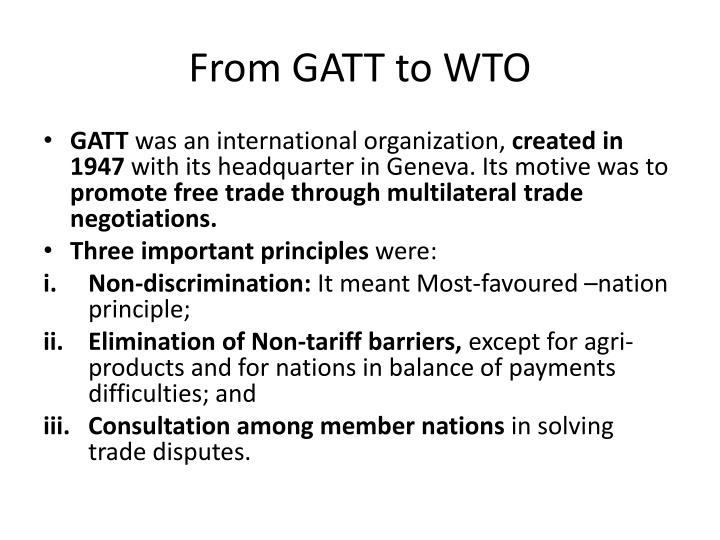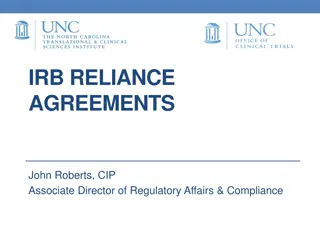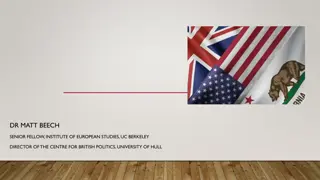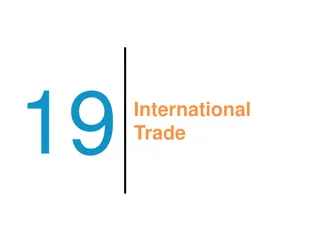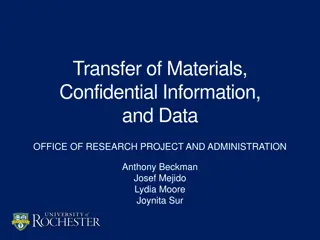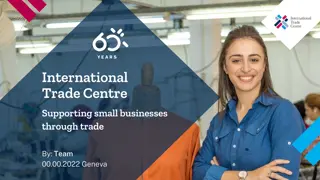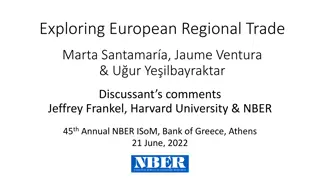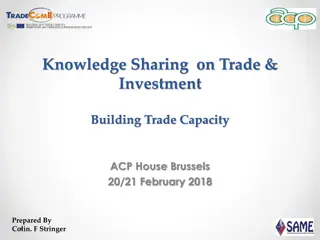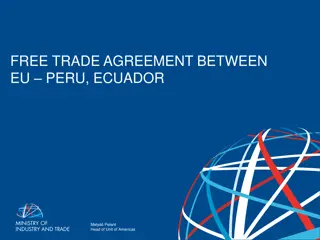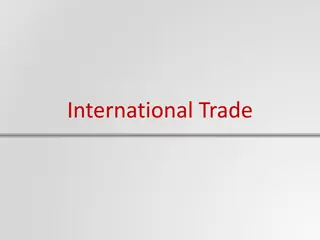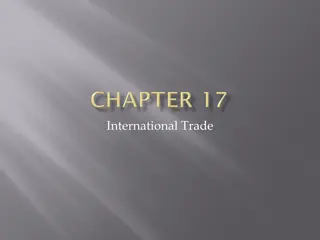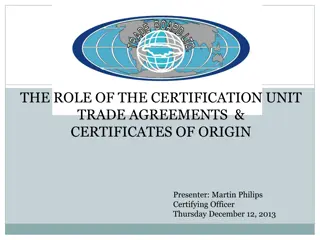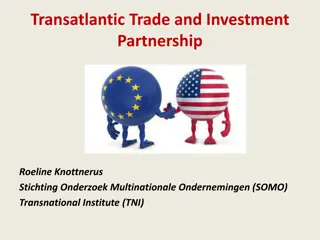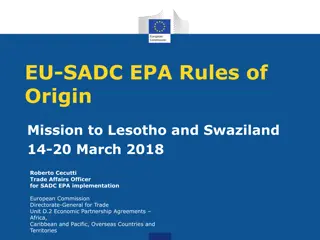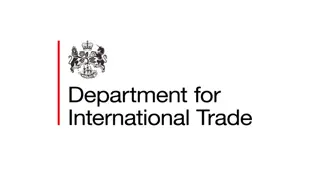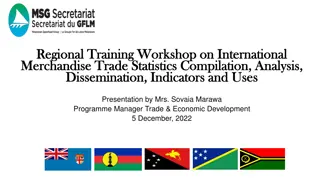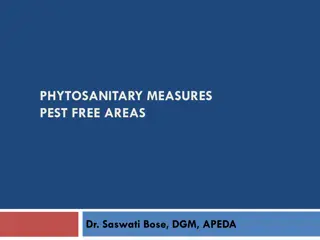Evolution of International Trade Agreements
The transition from GATT to WTO marked significant advancements in global trade regulations, with a focus on free trade promotion, dispute resolution, and enhanced transparency. The WTO, established in 1995, serves as a platform for member nations to negotiate trade agreements, reduce import duties, eliminate discriminatory practices, monitor trade policies, address emerging issues, and provide a robust dispute settlement mechanism.
Download Presentation

Please find below an Image/Link to download the presentation.
The content on the website is provided AS IS for your information and personal use only. It may not be sold, licensed, or shared on other websites without obtaining consent from the author.If you encounter any issues during the download, it is possible that the publisher has removed the file from their server.
You are allowed to download the files provided on this website for personal or commercial use, subject to the condition that they are used lawfully. All files are the property of their respective owners.
The content on the website is provided AS IS for your information and personal use only. It may not be sold, licensed, or shared on other websites without obtaining consent from the author.
E N D
Presentation Transcript
From GATT to WTO GATT was an international organization, created in 1947 with its headquarter in Geneva. Its motive was to promote free trade through multilateral trade negotiations. Three important principles were: i. Non-discrimination: It meant Most-favoured nation principle; ii. Elimination of Non-tariff barriers, except for agri- products and for nations in balance of payments difficulties; and iii. Consultation among member nations in solving trade disputes.
From GATT to WTO (contd.) Until the Uruguay Round, however, no progress was made on agriculture or on textiles and clothing. The deal that finally allowed these sectors to be subjected to multilateral disciplines included the establishment of rules for trade in services and enforcement of intellectual property rights (IPRs), as well as the creation of the WTO. WTO operates by consensus it is member-driven. The coverage of the WTO is much wider. A change of great importance is that in contrast to the GATT, the WTO agreement is a single undertaking - all its provisions apply to all members. Under the GATT there was great flexibility for countries to opt out of new disciplines, and in practice many developing countries did not sign specific agreements on issues such as customs valuation or subsidies.
From GATT to WTO (contd.) Also important were changes in the area of dispute settlement, which became much more automatic with the adoption of a negative consensus rule. All members must oppose the findings in a dispute settlement to block adoption of reports). Finally, the secretariat acquired much greater transparency and surveillance functions through the creation of the Trade Policy Review Mechanism.
Functions of WTO The WTO was established in 1995 to administer the trade agreements negotiated by its members ( 144 countries by the end of 2001) in particular the General Agreement on Tariffs and Trade (GATT). The WTO deals with the global rules of trade between nations. Its main function is to ensure that trade flows as smoothly, predictably and freely as possible. To attain this objective WTO engages in the following functions: i. The WTO is a forum for international cooperation on trade-related policies-the creation of Codes of Conduct for member governments; ii. Reduction in import duties is the dominant function of the WTO;
Functions of WTO (contd.) iii. Elimination of discrimination (through most- favoured-nation treatment and the national treatment principles); iv. Elimination of quantitative and other trade barriers (through regular monitoring of trade policies of its members); v. Providing a forum for dealing with various emerging issues; and vi. It works as a united dispute-settlement system for its members (through Dispute Settlement Body).
Principles of WTO WTO has framed certain rules of the game for fair play. However, it is not concerned with the outcome. The five cardinal principles of trading system are: non- discrimination, reciprocity, enforceable commitments, transparency, and safety valves. Non-discrimination: Non-discrimination has two related subsets, viz., the most-favoured nation (MFN) rule and the national treatment. Rules in all agreements have embedded them. But their scope and nature differ across the agreements on goods, services, and intellectual property. The MFN principle states that there should be no discrimination between a product made in one country and the similar product made in another country.
Principles of WTO (contd.) Thus, if the tariff levied on a product from one country is 7 per cent, then the similar product being imported from any other country should also attract only the same rate. Exceptions to MFN principle are possible in case of free trade areas or customs unions and for preferential treatment of developing countries. MFN principle motivates importers to import from the lowest cost suppliers. It also provides smaller countries with a guarantee that larger countries will not exploit their market power by raising tariffs because of bad times or due to foreign policy compulsions. The principle also reduces negotiating costs, since what has been decided for one country the same is applicable to the rest.
Principles of WTO (contd.) Some exceptions to MFN principle are worth noting. First, the WTO allows members to form bilateral or regional customs unions or free trade areas and discriminatory treatment is allowed. Second, the WTO permits members to lower tariffs to developing countries without lowering them to developed countries. Third, the WTO permits escape clauses to safeguard infant industries and nourish economic growth for newly admitted developing countries. The national treatment principle requires that once foreign goods enter a country, they shall be treated at par with the local goods (Art. III, GATT). It means that with respect to taxes, charges, and regulations there would be no discrimination. This rule provides certainty to foreign suppliers with regard to regulatory environment in which they have to operate.
Reciprocity In the negotiating process reciprocity is a fundamental element. It means that a country which is prepared to make concessions in matters of liberalizing its trade can demand that its partners offer similar cuts in protection. Binding and Enforceable Commitments: Rules, if they cannot be endorsed, are of no value. The non- discrimination principle of the GATT ensures that market access commitments are implemented and maintained. The tariff commitments made by WTO members in a multilateral trade negotiation must be respected and there should be no resort to other, non- tariff, measures that have the effect of nullifying or impairing the value of the tariff concession.
Transparency Transparency is a legal obligation by which the member countries are required to publish their trade regulations, to establish and maintain institutions allowing for the review of administrative decisions affecting trade, to respond to requests for information by other members, and to notify changes in trade policies to the WTO. These internal transparency requirements are supplemented by multilateral surveillance of trade policies by WTO members, facilitated by periodic country-specific reports prepared by the WTO. Apart from reducing uncertainty with regard to prevailing policy stance it also reduces the pressure on dispute settlement system and also ensures legitimacy of the system.
Safety Valves Safety Valves: One of the principles embedded in the WTO is that, in specific circumstances, governments should be allowed to restrict trade. There are three types of provisions in this regard: i. Articles allowing for the use of trade measures to attain noneconomic objectives-protection of public health, national security, or safeguarding local industries seriously injured by competition; ii. Articles aimed at ensuring free competition to counter subsidies by foreign countries and dumping; and iii. Provisions permitting intervention in trade for economic reasons-serious balance of payments difficulties or supporting infant industries.
The Benefits of the WTO The system helps promote peace; Disputes are handled constructively; Rules make life easier for all; Free trade cuts cost of living; Consumers have more choice of products and qualities; Trade raises incomes; Trade stimulates growth; Governments are shielded from lobbying; The system encourages good government; and The qualitative and quantitative participation of developing countries in WTO negotiations has risen dramatically.
WTO and Developing Countries In recent decades, developing countries have dramatically increased their economic power, participation in international trade and engagement in the institutions that govern the multilateral trading system. Among the members of WTO over one-third are developing countries, of which roughly half are classified by the UNCTAD as being Least Developed Countries. These numbers imply that whenever broad consensus or unanimity is required, developing countries have the ability to influence proceedings at the WTO. Of course, in most matters economic size trumps country numbers. But in this regard too, developing countries have become increasingly influential at the WTO.
WTO and Developing(contd.) The recent emergence of China, Brazil, and India is an important development in this regard. During 2009, all three countries ranked in the top ten in terms of their gross domestic product, with China having the third largest economy in the world (after the EU and the USA) and India the fifth largest. The combined economic clout of developing countries at the WTO is now sizeable and increasing fast. These developments will undoubtedly affect the pace and the nature of future WTO negotiations. Their bargaining power has increased considerably due to formation of bargaining coalitions. Throughout the history of GATT and WTO developing countries were candidates for Special and Differential Treatment (STD) in the multilateral trading system due to their unique economic challenges.
Weaknesses of WTO/DSP Mechanism Only governments have a legal status in the WTO. Thus, at time, some of the important issues may not be taken up. Even though the number of developing countries using the DS mechanism has increased, litigation remains an expensive and technical business that many weaker countries are ill-equipped to take on. Though the WTO has fixed time limit for different steps of the DSP, yet the total time period is still very long and a huge damage may take place. Though the WTO has the judicial authority, but as far as punishment part is concerned the only instruments are national retaliation and international opprobrium. If the infringing country has a strong national interest then even the latter is generally not very effective.
Weaknesses of WTO(contd.) When there is national retaliation, it is the local importers who have to bear the burnt. The interests of customers in the local market also get affected, but they have no voice. Trade retaliation is inherently trade distorting. The member countries are unequal in terms of size. This inequality silences a small country, as it has no power, either institutional (diplomacy, legal counseling, etc.) or retaliation, to protest the infringement done by a major country. WTO has failed in getting its members agree on certain issues like agricultural subsidies and services. Developmental aspect of trade is yet to be gripped by WTO. Doha Round has yet not been concluded. Developing and less developed countries are not satisfied with the protective regime of developed countries. The developed countries do not want to eliminate subsidies.
Limitations and Challenges On paper, WTO is more democratic than the World Bank or IMF- but not quite in practice. There is an aristocracy, say US, EU, Japan, and Canada, the so called quad countries. The WTO lacks deliberative democracy in its negotiations. Deliberation requires a dialogue among equal subjects in an open, transparent and participatory way. Democratic deliberation is the exchange of information and arguments by advancing, supporting and criticizing different proposals and offering reasons for the positions taken. Deliberation is arguing and not bargaining.
Limitations and Challenges(contd.) First, many of the third world countries lack the research and information base to effectively participate in the negotiation of the complex agreements. Second, the different agreements are essentially negotiated by a small club of countries and majority of countries come into picture only when this club arrives at some conclusions. Future negotiations will be more complicated because LDCs will have to be involved in earlier stages so that they can defend their interests better. Most powerful countries usually agree on their world- trade negotiating positions in advance. The US, the EU, Japan and Canada (Quad) first decide their joint position, then invite other OECD countries to join them, and only then present it to a handful of the larger developing countries.
Limitations and Challenges(contd.) Many of the most important WTO negotiations have been in so-called Green Room discussions, which are restricted to twenty to thirty key negotiators. Third, the informal component of WTO decision-making has had an adverse impact on the coalitions of developing countries. And aid is often used as a lever to win over key Southern governments. Hence, the WTO has often been a divisive instrument, not well serving the interest of the South. Fourth, there is absence of staff parity from the developed and Third World countries, thus while seeking technical and other assistance from WTO, the general impression is that a particular line of ideology would prevail. Fifth, the developing countries fear the consequence of expressing their objections publicly, and hence choose the option of remaining silent.
Limitations and Challenges(contd.) A variety of threats and pressures are used by powerful nations to ensure that their positions are accepted. Finally, the technique of single undertaking is used to ensure that Third World countries cannot opt out of agreements which are not in their national interests. Even though the WTO charter formally commits it to poverty alleviation it is not seen by anyone as a primary WTO objective. The WTO has so far failed to make world trade for the poor. There is no process of social audit in place to see if, inter alia, there is poverty alleviation, employment generation, and gender equality promoted through trade. The problem is that the WTO has not been able to avoid being used by the rich countries. Thus, the WTO has not helped to raise living standards of the poor but to retain the trade advantages of the richest countries.
Limitations and Challenges(contd.) Developing countries have agreed to a grand bargain in which they lowered tariffs and agreed to respect patents in exchange of the abolition of rich- countries quotas on textiles and clothing, reduced agricultural protection, and abolition of voluntary export restraints. Developing countries have done their bit, but rich countries have reneged. The liberalism from above manifest in the creation of an international institution to encourage, manage, and regulate. International trade has still to overcome the existence of liberalism from below in the form of sovereign states defending their perceived national interests through a range of explicit and implicit protectionist measures.
